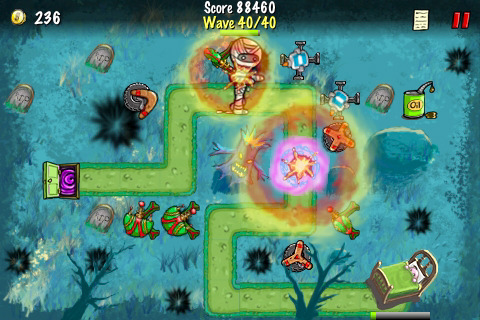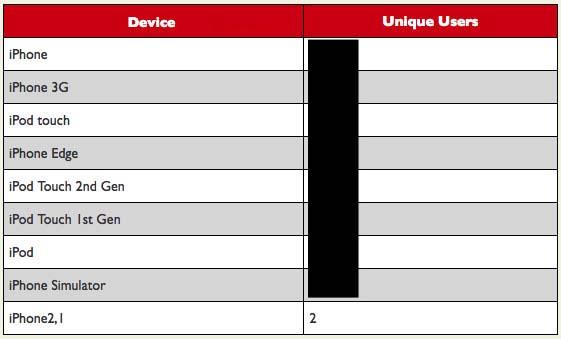News tagged ‘Mac’
Use iPhone to shoot lasers
All you need is:
- I/O Bridge with Servo Module
- Webcam
- 2 Servos
- Buzzer
- Laser Pointer
- Spare Electrical Components from parts bin (Transistor, Resistors, LEDs, etc.)
- X10 Module
Read more instructions.
Earth3D [AppStore, Free]
This is a wonderful 3d animation the Earth with the Moon and the Sun. Application is free in AppStore (link).
The new version of this app will be called Earth3D+. More planets will be added. It will appear in AppStore soon. Watch the video:
 Leave a comment, read comments [1]
Leave a comment, read comments [1]
Google Latitude
Google announced a new location tracking feature of Google Maps that will allow you to share your current location with your friends and family. The new service is called .
While launching initially on BlackBerry, Windows Mobile, Android and Symbian S60, Google hopes to release an iPhone version soon.
via macrumors
TheCreeps [AppStore, Games, Free]

This is one more tower defence type game. Lots of fun, good graphics.

It costs just $4.99 (AppStore ). There is also free lite version (AppStore ). Watch the video:
Time lapse photography [AppStore]
TimeLapse ($0.99, ) uses your iPhone's camera to take photos at regular intervals. You can have one photo snapped as infrequently as every 24 hours, or as often as every 10 seconds. After you've collected all of your photos, you can easily dump them into iMovie or QuickTime Pro and make a simple time lapse movie.
via tuaw
Archibald's Adventures [AppStore, Games]
Nice game for $4.99 (AppStore ), but you can try free lite version (AppStore ).
Watch the video:
Gmail tasks
Google has just announced a new way to manage your Gmail Tasks from your mobile device or your iGoogle homepage.
NFS Undercover
Many users are waiting for this game. Here is a pre-release video:
Apple and Adobe collaborate on Flash for iPhone

Bloomberg reports that Adobe's Chief Executive Officer Shantanu Narayen has revealed that Adobe with Apple on bringing Flash support to the iPhone:
It's a hard technical challenge, and that's part of the reason Apple and Adobe are collaborating, Narayen said today in a Bloomberg Television interview from the World Economic Forum in Davos, Switzerland. The ball is in our court. The onus is on us to deliver.
Flash is a very popular web plug-in that is used to deliver animation and video content on the web. Apple's iPhone has notably not supported Flash since its launch.
The surprising part there is the admission that Apple is working with Adobe on the project.
via macrumors
Falling Balls [AppStore, Free]

This game made it to Top 3 in US AppStore. Very nice.


This game is free. Here is a to AppStore.
Watch the video:
Springboard rotation
This application will rotate Springboard according to iPhones accelerometer data. Will be avaliable quite soon.
Firmware 2.2.1 is officially hacked

Yes, DevTeam released new version of their software. First of all, please, do NOT use unofficial software from unknows sites (f.e. quickpwm.com). We recommend to download from torrent or official mirors.
We regulary publish latets and links. Use them or the same ones from DevTeam .
So:
- iPhone 2G and iPod Touch: update to 2.2.1 with iTunes and run to .
- iPod Touch 2G: sorry, you need to wait a bit more
- iPhone 3G + NO UNLOCK: If you do not need unlock, you are using your iPhone with one carrier or you hae factory unlcoked iPhone, just restore or upgrade to 2.2.1 using iTunes and use to and add Cydia and Installer.
- iPhone 3G + UNLOCK: you need to preserve current baseband software. Preserving the baseband will ensure that you can still use “” the iPhone 3G . To upgrade your phone to 2.2.1 and preserve the state of the baseband you need to create a custom .ipsw with . This custom .ipsw will not contain the baseband update but of course will still allow all the cool new stuff from 2.2.1. is only available for Mac OS X.
DevTeam updated to version 0.9.7 to work with modified (!!!) firmware 2.2.1, in which you preserve old baseband from firmware 2.2.
More Details about iPhone 2,1

Yesterday we first info about iPhone 2,1. PinchMedia follows up with what few details they have about the usage of the device.
- 1st spotting of the "iPhone 2,1" device occured in early October 2008
- Usage picked up in mid-December 2008
- A few dozen distinct "iPhone 2,1" devices have been detected
- Almost exclusively located in south San Francisco Bay Area
- Both AT&T and Wi-Fi connections
PinchMedia provides iPhone developers with ad serving and analytic tracking software to embed within iPhone applications. This is how the the iPhone 2,1 devices have been detected.
via macrumors
CubeCheater - Rubik's Cube puzzle solver
A new iPhone app called CubeCheater helps you solve the classic Rubik's Cube puzzle toy using a mix of sophisticated algorithms and simple image-recognition technology. CubeCheater sells for $0.99 in the App Store ().
Here's how it works. You take six pictures of your mixed up Rubik's Cube using the iPhone's camera — one photo per side. If you have an iPod Touch, you can also tap in the color combos manually. CubeCheater is able to recognize the placement of each colored square and generate a 3D map of your cube. It then figures out the quickest path to solving the puzzle and gives you a set of easy-to-follow, step-by-step instructions.
via wired
Next generation iPhone proof in firmware 2.2.1
MacRumors has discovered that iPhone's firmware has evidence of the next generation iPhone which has been designated "iPhone2,1". This new model number can be found in the USBDeviceConfiguration.plist in an unencrypted firmware.

Apple uses these models numbers to distinguish between different hardware models. The original iPhone carries the model number of "iPhone 1,1" while the 3G iPhone is labeled "iPhone 1,2". These numbers do not change for simple storage increases and instead represent functionally different devices. Similarly, the iPod Touch was originally introduced as the "iPod 1,1" and the most recent hardware revision was labeled "iPod2,1".
Meanwhile, at least one developer has noticed actual "iPhone2,1" models in use based on PinchMedia ad serving reports.

via macrumors